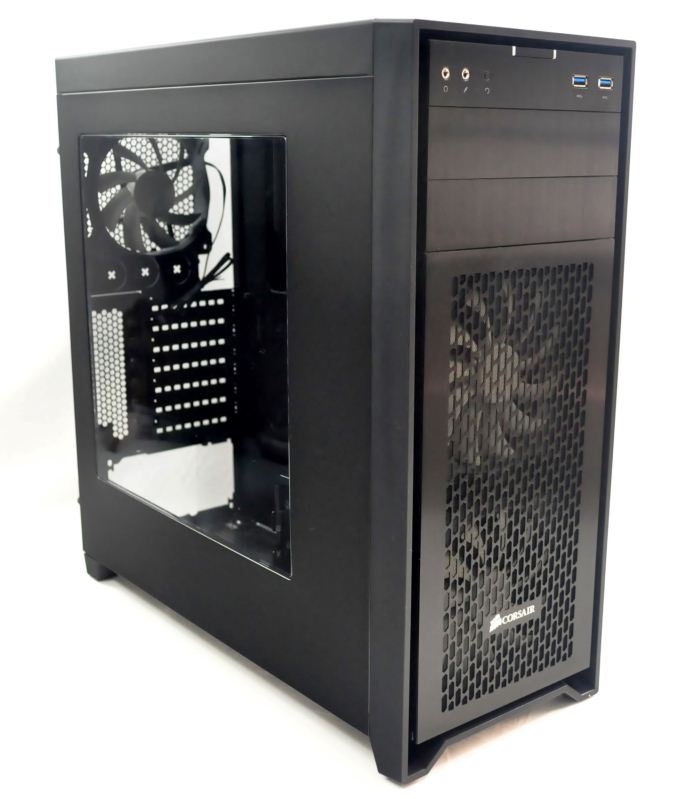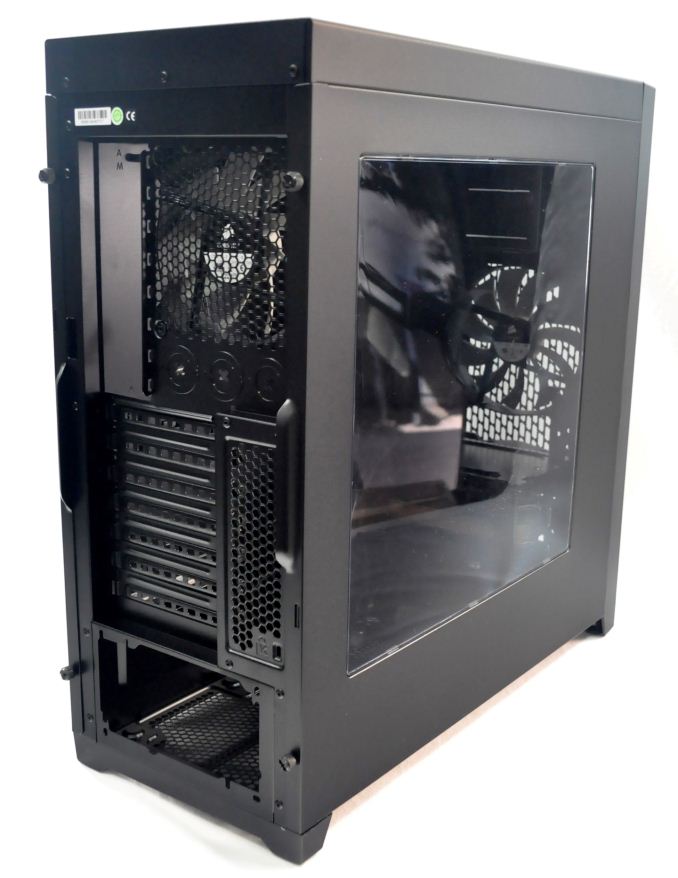Corsair Obsidian 450D Case Review
by E. Fylladitakis on April 4, 2014 6:00 AM EST- Posted in
- Cases/Cooling/PSUs
- Corsair
- mid-tower
- Case
Corsair Obsidian 450D Exterior
As mentioned on the previous page, the Obsidian 450D is a bridge between the smaller 350D and the larger 750D. It shares the same exact aesthetic design as the rest of the series, a post-minimalistic approach with clean lines, sharp angles, and basic geometric shapes. In fact, if not for the perforated front intake panel, the Obsidian 450D could be easily mistaken for a 350D or a 750D instead. The chassis of the case is made out of 1mm thick SECC steel and the front panel is made out of 2mm plastic. The front panel also forms the two front feet of the Obsidian 450D, while the rear plastic feet are each attached to the metallic chassis.
Two USB 3.0 ports and two 3.5" audio jacks (headphones, microphone) can be found near the top of the faceplate, right above the two 5.25" bays of the case. The power on button has a rectangular shape and is placed at the middle top part of the faceplate, between the power on and HDD activity LED lights. The reset button is much smaller and round, aligning in shape and size with the audio jacks.
The rest of the fascia is a removable, washable air intake filter. It can be removed very easily, by simply applying a little pressure at the top two corners simultaneously. Actually, it is so easy and simple to remove that it would probably be a bad idea to leave the Obsidian 450D in the vicinity of unattended children, especially as the removal of the filter reveals two unguarded 140mm intake fans.
The Obsidian 450D has plenty of ventilation and also plenty of filters installed. Aside from the front filter, there are large filters covering the bottom and the top panels of the case. The bottom panel is almost entirely perforated and a single magnetic filter covers it from one side to the other. It can be removed by simply pulling it off and reattached just as easily; with a little practice and if you have thin fingers, it is possible to remove/reattach the filter without having to roll the case on its side, as the feet of the Obsidian 450D are rather tall. Another similar magnetic filter covers the top panel as well, which actually is little more than a flexible magnetic frame with a dense mesh glued on it, but it matches the theme of the case perfectly and can be removed-cleaned-reattached within seconds.
Although the right side panel of the Obsidian 450D is entirely plain and uninteresting, the left side panel is one of its most prominent features. An acrylic window covers most of the left side panel, exposing much of the interior, including part of the PSU compartment. Due to the window, the left side panel cannot assist with the cooling of the case. Corsair, obviously in an effort to maximize ventilation and offset what little loss the solid side panels could impose, perforated what they could at the rear side of the case, including the expansion slot covers. It is interesting to note that there are three round holes for liquid cooling hoses and or cables; however there are no rubber grommets, only solid metal covers that can be permanently punched out. We realize that the percentage of users that will actually use an external liquid cooling kit with the Obsidian 450D is low but the installation of three rubber grommets shouldn't be much of an issue for a $120 case.


















36 Comments
View All Comments
lmcd - Friday, April 4, 2014 - link
I think a reference article suggesting one generic system the test loads would be equal could help?It's tough to envision where these thermal dissipations fall in with the market.
vgray35@hotmail.com - Saturday, April 5, 2014 - link
I do not concur with your reasoning in large part. Yes comparisons are excruciatingly difficult, and in many instances possibly even impossible to construe reasonable conclusions. So what! Comparisons are not everything. Comparisons are difficult yes, but nevertheless a figure of merit in the form of a specific test case gives an idea of what the Case design is capable of achieving, quite apart from the rudimentary machinations of comparing results. We have a need for comparisons to some extent n you constant heat load idea will help here, but we also have a need for a SPECIFIC perspective on Case design. Specific test results are not invalid just because comparisons are difficult. Once I have chosen a specific Computer Case for a build, I use the specific test case as a representative example of internal case design, in terms of airflow and specific components. I am then no longer interested in comparisons.Difficulty in comparing results in no wise invalidates the usefulness of a specific test case, somehow making it useless. Measuring total heat load for a specific test case with CPU etc, temperature rises, is just that - a specific test case - that is not invalidated by some different testing methodology. It remains a real world test - just a SPECIFIC case test, comparisons aside. A single snapshot view and heat load example is not useless expressed in the form of specific components and temperature differentials.
Applying a constant heat load is a good idea as an alternative test, but you reach too far when you declare specific test cases are invalid, just because comparisons of specific test cases are difficult.They provide a figure of merit of one sort, and these are not necessarily intended to be compared with other results. Difficulty in comparisons is not a legitimate reason for abandoning specific test cases, as comparisons are not the holy grail of these results.
I like the notion that: "these specific components loaded to this specific heat load produces a specific series of temperature differentials with this specific Case and components". For example I may want to build the specific test case with only minor changes, and the impact of making the minor changes is what is of interest - not comparisons with other specific tests.
The whole gamut of your methodology intimates that "comparisons are impossible to make", and therefore specific test cases are invalid. That is wrong. Yes settings change things a lot - so just measure input power and temperatures and be done with it. Specific test cases serve much more beyond merely being used for comparison purposes, which makes them valid real world test cases.
vgray35@hotmail.com - Saturday, April 5, 2014 - link
Guess what! real work includes interacting with your client base. Reading review comments constitutes a part of your real word job.FriendlyUser - Friday, April 4, 2014 - link
Great review! I'd really like to see a similar review of the 750D one day, since I'm interested in more spacious enclosures.HisDivineOrder - Friday, April 4, 2014 - link
I wish Corsair would iterate on the 550D with a cube-shape. That'd be hot as an Obsidian product. The current Corsair cube leaves much to be desired.rpjkw11 - Friday, April 4, 2014 - link
I really like Corsair's use of magnetic dust filters, but not on the bottom as in this case. Tipping a case to remove a dust filter for cleaning is, according to Murphy's Law, an accident waiting to happen. That's nitpicking, true, but one little Ooops can ruin one's day, so for me at least, it's a deal breaker. Except for that, the 450D is a great looking, very well designed case.kmmatney - Friday, April 4, 2014 - link
You don't have to tip the case to get the bottom filter - you can use a screw driver to pop it off, or even just your fingers. Well worth it for a dust-free case.FoRealz - Friday, April 4, 2014 - link
Can you please list the weight of the cases? Many thanks!E.Fyll - Friday, April 4, 2014 - link
Yes, I will in future reviews, I just received a proper scale that was bought for that specific purpose.Subyman - Friday, April 4, 2014 - link
It seems Corsair keeps stepping down the quality of plastics they use. The front facia looks like really cheap plastic compared to their older products. This doesn't seem like a $100+ case.